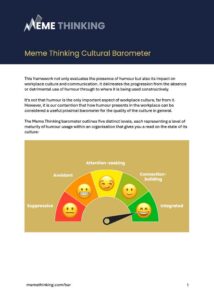Humour isn’t just about punchlines and memes. It’s often the canary in the cultural coal mine — a proxy for psychological safety, shared values, and how well your team handles the hard stuff.
So what does the way your team jokes (or doesn’t) really say about your culture?
Let us introduce you to the Meme Thinking Cultural Barometer — a five-level diagnostic tool disguised as a humorous self-help guide. From deadpan silences to leader-approved GIFs, this model helps you assess the maturity of humour in your workplace.
Can you relate to any of the following?
- You hear a joke in the meeting and immediately check HR policies
- Someone makes a joke and says “too soon?
- The loudest person in the room is the only one laughing
- Your team has a shared meme thread
- Your CEO opens town hall with a custom GIF
These are some of the different ways we see humour manifest in organisations, and they map to the 5 levels of the Meme Thinking Cultural Barometer.
The Five Levels
1. Suppressive
- Scene: A junior staff member tries to lighten a tense all-hands meeting with a light remark about everyone’s overflowing inboxes. The room goes silent. A manager raises an eyebrow and says, “Let’s keep this professional, please.”
- What it says about your culture: Laughter feels risky. Creativity and honest dialogue are suppressed. People walk on eggshells.
2. Avoidant
- Scene: During a retrospective, someone brings up how the team keeps missing sprint goals. A colleague jumps in with, “Well, we are agile — missing deadlines is basically part of the process, right?” Nervous laughter. The topic dies.
- What it says about your culture: Jokes are shields, not bridges. Real issues are swept under the rug by nervous giggles.
3. Attention-seeking
- Scene: During a team lunch, one person dominates the conversation with sarcastic impressions of the sales team. Some people laugh, but one colleague quietly leaves early. Later, they admit they don’t feel safe speaking up.
- What it says about your culture: Humour is a spotlight, not a campfire. Used to centre ego, not connection. Some people become the punchline.
4. Connection-building
- Scene: The team hits a tricky roadblock. One person sends a meme in Slack that pokes fun at the challenge — “When you realise you scoped the impossible… but you’re in it together.” It gets emoji reactions and turns into a productive thread.
- What it says about your culture: Humour brings people together. It names the challenge but doesn’t deflect it. Builds rapport, not silos.
5. Integrated Humour
- Scene: At the start of the year, the team jokingly dubbed a stretch goal “Project Unicorn.” Months later, the unicorn appears in a quarterly slide deck—horn, glitter, and all—used to celebrate progress and acknowledge how far they’ve come. Everyone laughs and reminisces. The humour is tied to collective effort, not individual embarrassment.
- What it says about your culture: Shared jokes become cultural glue. They honour the journey and remind everyone that they’re seen, understood, remembered, and we’re all in it together.
Putting It to Work
Some ideas for how you might action this in your team(s):
- Run a team reflection: Which level are we at now? Where do we want to be?
- Celebrate inclusive humour: Encourage jokes that connect, not divide.
- Get to know each other in personal ways (that align with code of conduct)
- Explore things that make us feel safe at work as a team.
- Brainstorm ideas for how you might bring some levity and creativity into future projects.
Most importantly…
If you had to boil Meme Thinking down to one idea, it’s this:
Humour belongs in the workplace
If and when this gets lost, we know that poor workplace outcomes follow. So when in doubt, let laughter be your guide.


